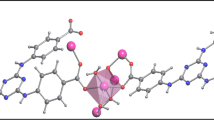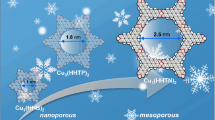Abstract
A novel polyoxometalate compound consisting of Anderson-type anions and trivalent lanthanide cations, [Er2(H2O)14Cr(OH)6Mo6O18][Cr(OH)6Mo6O18]·14H2O (1), has been synthesized in aqueous solution and characterized by single crystal X-ray diffraction, elemental analyses, IR spectrum and TG analyses. Single crystal X-ray diffraction reveals that compound 1 crystallizes in the triclinic space group P-1 with a = 11.046 (5) Å, b = 11.653 (5) Å, c = 13.935 (5) Å, α = 75.006 (5)°, β = 84.497(5)°, γ = 89.515(5)°. The bulk ions of compound 1 in the cell unit exhibit orthorhombic C-centered packing mode, the eight [Cr(2)(OH)6Mo6O18]3− anions occupy the eight corners and the two [Er2(H2O)14Cr(OH)6Mo6O18]3+ cations occupy the centres of two opposite faces, whereas anions and cations are linked together via hydrogen bonding interactions tightly forming a three-dimensional supramolecular architecture, which contains one-dimensional channels occupied by free water molecules.
Index Abstract
The bulk ions of compound 1 in the cell unit exhibit orthorhombic C-centered packing mode, the eight [Cr(2)(OH)6Mo6O18]3− anions occupy the eight corners and the two [Er2(H2O)14Cr(OH)6Mo6O18]3+ cations occupy the centres of two opposite faces, whereas anions and cations are linked together via hydrogen bonding interactions tightly forming a three-dimensional supramolecular architecture, which contains one-dimensional channels occupied by free water molecules.









Similar content being viewed by others
References
Hill CL (1998) Chem Rev 98:1
(a) Coronado E, Galan-Mascaros JR, Gimenez-Saiz C, Gomez-Garcia CJ (1993) Adv Mater 283:4; (b) Casan-Pastor N, Baker LCW (1992) J Am Chem Soc 114:345; (c) Yamase T (1993) Mol Eng 3:241
(a) Reinoso S, Vitoria P, Lezama L, Luque A, Gutiérrez-Zorrilla JM (2003) Inorg Chem 42:3709; (b) Zhang H, Duan LY, Lan Y, Wang EB, Hu CW (2003) Inorg Chem 42:8053
Bareyt S, Piligkos S, Hasenknopf B, Gouzerh P, Lacôte E, Thorimbert S, Malacria M (2003) Angew Chem Int Ed Engl 42:3404
(a) Chen YG, Yan LK, Hao XR, Liu K, Wang XH, Lu PP (2006) Inorg Chim Acta 359:2550; (b) Xu L, Lu M, Xu BB, Wei YG, Peng ZH, Powell DR (2002) Angew Chem Int Ed 41:4129
(a) Shivaiah V, Reddy PVN, Cronin L, Das SKJ (2002) Chem Soc Dalton Trans 3781; (b) Drewes D, Limanski EM, Krebs BJ (2004) Chem Soc Dalton Trans 2087; (c) Drewes D, Limanski EM, Krebs BJ (2004) Eur J Inorg Chem 4849; (d) Gao B, Liu SX, Xie LH, Yu M, Zhang CD, Sun CY, Cheng HY (2006) J Solid State Chem 179:1681; (e) An HY, Xiao DR, Wang EB, Li YG, Xu L (2005) Eur J Inorg Chem 854
(a) Khan MI, Yohannes E, Powell D (1999) Chem Commun 23; (b) Khan MI, Yohannes E, Doedens R (1999) Angew Chem Int Ed 38:1292; (c) Cui XB, Xu JQ, Meng H, Zheng ST, Yang GY (2004) Inorg Chem 43:8005
(a) Kalcher K (1990) Electroanalysis 2:419; (b) Wang XL, Wang EB, Lan Y, Hu CW (2002) Electroanalysis 14:1116
Dossing A (2005) Eur J Inorg Chem 1425
Benelli C, Gatteschi D (2002) Chem Rev 102:2369
Kobayashi S, Sugiura M, Kitagawa H, Lam WWL (2002) Chem Rev 102:2227
Wang XL, Guo YQ, Li YG, Wang EB, Hu CW, Hu NH (2003) Inorg Chem 42:4135
(a) An HY, Xiao DR, Wang EB, Sun CY, Li YG, Xu L (2005) J Mol Struct 751:184; (b) An HY, Xiao DR, Wang EB, Sun CY, Xu L (2005) J Mol Struct 743:117; (c) An HY, Li YG, Xiao DR, Wang EB, Sun CY (2006) Cryst Growth Des 6:1107
Perloff A (1970) Inorg Chem 9:2228
(a) Sheldrick GM (1997) SHELXS 97, Program for crystal structure solution. University of Göttingen, Germany; (b) Sheldrick GM (1997) SHELXS 97, Program for crystal structure refinement. University of Göttingen, Germany
(a) International Tables for X-ray Crystallography (1962) Kynoch Press, Birmingham, England (Present distributor: Kluwer Academic Publisher, Dordrecht), vol III, p 72; (b) Krische MJ, Lehn JM (2000) Struct Bonding 96:3
(a) Yuan M, Li YG, Wang EB, Lu Y, Hu CW, Hu NH, Jia HQ (2002) J Chem Soc Dalton Trans 2916; (b) HanZB, Wang EB, Luan GY, Li YG, Zhang H, Duan YB, Hu CW, Hu NH (2002) J Mater Chem 12:1169
Brown ID, Altermatt D (1985) Acta Crystallogr Sect B 41:244
Author information
Authors and Affiliations
Corresponding author
Electronic supplementary material
Rights and permissions
About this article
Cite this article
Shi, D., Hu, M., Zhang, C. et al. Synthesis and Structure of a Novel Polyoxomolybdate Lanthanide Complex: [Er2(H2O)14Cr(OH)6Mo6O18][Cr(OH)6Mo6O18] · 14H2O. J Chem Crystallogr 38, 695–700 (2008). https://doi.org/10.1007/s10870-008-9378-y
Received:
Accepted:
Published:
Issue Date:
DOI: https://doi.org/10.1007/s10870-008-9378-y




